DSpace at VNU: Bullera hoabinhensis sp nov., a new ballistoconidiogenous yeast isolated from a plant leaf collected in Vietnam
Bạn đang xem bản rút gọn của tài liệu. Xem và tải ngay bản đầy đủ của tài liệu tại đây (445.45 KB, 8 trang )
J. Gen. Appl. Microbiol., 51, 335–342 (2005)
Full Paper
Bullera hoabinhensis sp. nov., a new ballistoconidiogenous yeast
isolated from a plant leaf collected in Vietnam
Dao Thi Luong,1, * Masako Takashima,2 Pham Van Ty,1 Nguyen Lan Dung,1 and Takashi Nakase3
1
Vietnam Type Culture Collection, Center of Biotechnology, Vietnam National University,
Hanoi, 144 Xuan Thuy, Cau Giay, Hanoi, Vietnam
2
Microbe Division/Japan Collection of Microorganisms, RIKEN BioResource Center,
Wako, Saitama 351–0198, Japan
3
Biological Resource Center (NBRC), Department of Biotechnology,
National Institute of Technology and Evaluation, Chiba 292–0818, Japan
(Received November 12, 2004; accepted September 2, 2005)
VY-68, a ballistoconidiogenous yeast strain, isolated from a plant leaf at Cuc Phuong National
Park of Ninh Binh Province, Vietnam, was assigned to the genus Bullera based on morphological
and chemotaxonomical characteristics. Based on the sequence analyses of 18S rDNA, D1/D2 region of 26S rDNA, and internal transcribed spacer regions (ITS), VY-68 was phylogenetically
closely related to Bullera pseudoalba and Cryptococcus cellulolyticus. DNA-DNA reassociation
experiments among VY-68, B. pseudoalba and C. cellulolyticus revealed that strain VY-68 is a
distinct species, and the latter two are conspecific. Bullera hoabinhensis is proposed for VY-68.
Key Words——Bullera hoabinhensis sp. nov.; systematics
Introduction
One hundred and twenty-one strains of ballistoconidiogenous yeasts were isolated from plant materials
collected in Cuc Phuong National Park of Ninh Binh
Province, Vietnam. Eighty-five strains selected for the
morphology of their ballistoconidia and colony appearances were assigned to four genera: Bullera (39
strains), Kockovaella (5 strains), Sporobolomyces (39
strains) and Tilletiopsis (2 strains) based on their morphological and chemotaxonomical characteristics.
Five strains of the genus Kockovaella represented 4
new species, which have already been described as K.
calophylli, K. cucphuongensis, K. litseae and K. vietnamensis (Luong et al., 2000). Fifteen of 39 strains of
genus Bullera seemed to represent undescribed
* Address reprint requests to: Dr. Dao Thi Luong, Vietnam
Type Culture Collection, Center of Biotechnology, Vietnam National University, Hanoi, 144 Xuan Thuy, Cau Giay, Hanoi, Vietnam.
species. Of these, Bullera hoabinhensis VY-68T, belonging to the Bulleromyces clade of Scorzetti et al.
(2002), is discussed in this report, based on a single
isolate.
Materials and Methods
Yeast strain. The yeast strain used in this study
was isolated from a plant leaf collected in Cuc Phuong
National Park of Ninh Binh Province, Vietnam (Table
1), using the ballistoconidium-fall method on YM agar
as reported by Nakase and Takashima (1993).
Morphological, physiological and biochemical characteristics. Most methods used for the examination
of morphological, physiological and biochemical characteristics were described by Yarrow (1998). The determination of maximum growth temperature was
made in YM broth, using metal block baths. The assimilation of nitrogen compounds was determined by
the method of Nakase and Suzuki (1986b). The vita-
336
LUONG et al.
min requirement followed the method of Komagata
and Nakase (1967).
Chemotaxonomic characteristics. Extraction, purification and identification of ubiquinones were carried
out according to the method of Nakase and Suzuki
(1986b). The presence or absence of xylose in the
cells was analyzed by thin-layer chromatography
(Nakase et al., 1976) after hydrolyzing the cells with
trifluoroacetic acid (Suzuki and Nakase, 1988).
Sequencing and phylogenetic analysis. The se-
Fig. 1. Phylogenetic tree of Bullera hoabinhensis VY-68T
and related species based on 18S rDNA sequences.
The tree was constructed from the evolutionary distance data
according to Kimura (1980) using the neighbour-joining method
(Saitou and Nei, 1987) with bootstrapping (Felsenstein, 1985).
The numerals represent the results from 1,000 replicate bootstrap samplings. Reference sequences were retrieved from
GenBank/DDBJ under the accession numbers indicated.
Table 1.
Vol. 51
quences of 18S rDNA, ITS regions including 5.8S
rDNA and the D1/D2 region of 26S rDNA, were determined after amplifying the DNA using PCR. Both
strands were sequenced directly (Kurtzman and Robnett, 1997; Takashima and Nakase, 1999). Generated
sequences were aligned with related species by using
the CLUSTAL W ver. 1.74 computer program (Thompson et al., 1994). Reference sequences used for the
phylogenetic study were obtained from the database.
The phylogenetic tree was constructed from the evolutionary distance data according to Kimura (1980) using
the neighbor-joining method (Saitou and Nei, 1987).
Sites where gaps existed in any sequences were excluded. Bootstrap analyses (Felsenstein, 1985) were
performed from 1,000 random resamplings. For a
comparison of ITS regions among closely related
species, pairwise sequences were aligned by sight,
and the sequence similarity including gaps was calculated.
DNA-DNA relatedness. Isolation and purification of
nuclear DNA was carried out according to Takashima
and Nakase (2000). The DNA base composition was
determined by HPLC after enzymatic digestion of DNA
to deoxyribonucleosides (Tamaoka and Komagata,
1984). The DNA-GC Kit (Yamasa Shoyu Co., Ltd.,
Chiba, Japan) was used as a quantitative standard.
DNA-DNA reassociation experiments were performed
by a membrane-filter method (Hamamoto and Nakase,
1995).
Results and Discussion
Taxonomic position of VY-68
A ballistoconidiogenous yeast strain, VY-68, was
characterized based on the presence of xylose in the
cells, of Q-10 as a major ubiquinone and the production of symmetrical ballistoconidia and budding cells.
Strains used in this study.
DDBJ accession numbers
Species
Bullera hoabinhensis sp.nov.
B. pseudoalba
Cryptococcus cellulolyticus
C. laurentii
T
Type strain.
Strain
VY-68T
JCM 5290T
JCM 9707T
JCM 9066T
Source
Anadendrum montanum
Dead leaf of Oryza sativa
Decayed wood
Palmwine
18S rDNA
ITS & 5.8S
D1/D2
AB110694
AB110695
AB193347
2005
A new species of Bullera
337
Fig. 2. Phylogenetic tree of Bullera hoabinhensis VY-68T and related species based on the sequence of the D1/D2
region of 26S rDNA.
The tree was constructed from the evolutionary distance data according to Kimura (1980) using the neighbour-joining method (Saitou and Nei, 1987) with bootstrapping (Felsenstein, 1985). The numerals represent the results from
1,000 replicate bootstrap samplings. Reference sequences were retrieved from GenBank/DDBJ under the accession
numbers indicated.
Based on these results, the isolate was assigned to
the genus Bullera (Boekhout and Nakase, 1998).
A phylogenetic tree was constructed based on the
18S rDNA sequences of the strain and 34 species of
the genera Bullera, Bulleromyces, Cryptococcus,
Dioszegia, Fellomyces, Filobasidium, Kockovaella,
Sterigmatosporidium, Trichosporon and Tsuchiyaea.
Bullera hoabinhensis VY-68T was located at the
Bulleromyces clade, and made a cluster with Bullera
pseudoalba, Cryptococcus cellulolyticus (84% bootstrap value) that connected with C. laurentii with 100%
bootstrap support.
Fell et al. (2000), Kurtzman and Robnett (1998), and
Sugita and Nishikawa (2003) demonstrated that yeast
strains could be identified to the species level by molecular phylogenetic analysis using D1/D2 sequences
of 26S rDNA. A phylogenetic tree was constructed
based on the D1/D2 sequences of 26S rDNA of B.
hoabinhensis VY-68T and 30 species of the genera
Auriculibuller, Bullera, Bulleromyces, Cryptococcus,
Dioszegia, Papiliotrema, Sirobasidium, Tremella, Trichosporon, Trimorphomyces and Tsuchiyaea (Fig. 2). B.
hoabinhensis VY-68T clustered with B. pseudoalba and
C. cellulolyticus, which is strongly supported (100%)
by bootstrap analysis.
The sequences of ITS regions were determined and
a phylogenetic tree of B. hoabinhensis VY-68T and
28 species of the genera Auriculibuller, Bullera, Bulleromyces, Cryptococcus, Fellomyces, Kockovaella,
Papiliotrema, Sirobasidium, Tremella and Trichosporon
was constructed (Fig. 3). B. hoabinhensis VY-68T also
made a cluster with B. pseudoalba and C. cellulolyticus, which is strongly supported (100%) by bootstrap
analysis. The sequence similarity between B. hoabinhensis VY-68T and phylogenetically closely related
species was calculated. The result showed that the sequence similarity between the ITS1 region of VY-68T
and that of B. pseudoalba and C. cellulolyticus was
94.7%, and that in the case of the ITS2 region was
91.6–92.1%. These results indicated that B. hoabin-
338
LUONG et al.
hensis VY-68T was distinct from the known Bullera
species.
Further experiments were made to confirm the taxonomic position of B. hoabinhensis VY-68T, B.
pseudoalba and C. cellulolyticus. The GϩC content of
cells of B. hoabinhensis VY-68T was 54 mol% different
from those of B. pseudoalba (52 mol%), C. cellulolyticus (52 mol%) and C. laurentii (58 mol%). DNA-DNA
Vol. 51
reassociation experiments (Table 2) showed that B.
hoabinhensis VY-68T had a low reassociation value to
reference species (7–14%). Based on these facts,
strain VY-68T is considered to be a new species.
Hence, Bullera hoabinhensis sp. nov is described.
Differential physiological and biochemical characteristics for new and known species of Bullera are listed
in Table 3. Bullera hoabinhensis sp. nov. is easily distinguished from reference species by the assimilation
of melibiose, D-glucitol, sodium nitrite, and by growth in
the medium containing 50% glucose.
Cryptococcus cellulolyticus is a synonym of Bullera
pseudoalba
As shown in Table 2, DNA-DNA reassociation experiments showed 70–78% DNA relatedness between B.
pseudoalba (Nakase and Suzuki, 1986a) and C. cellulolyticus (Nakase et al., 1996), indicating that they are
conspecific. Scorzetti et al. (2002) reported that C. cellulolyticus and B. pseudoalba had identical D1/D2 and
ITS sequences, which would suggest conspecificity
Fig. 3. Phylogenetic tree of Bullera hoabinhensis VY-68T
and related species based on the sequence of the ITS regions
of rDNA.
The tree was constructed from the evolutionary distance data
according to Kimura (1980) using the neighbour-joining method
(Saitou and Nei, 1987) with bootstrapping (Felsenstein, 1985).
The numerals represent the results from 1,000 replicate bootstrap samplings. Reference sequences were retrieved from
GenBank/DDBJ under the accession numbers indicated.
Table 2.
Fig. 4. Bullera hoabinhensis VY-68T.
A, Vegetative cells grown in YM broth for 5 days at 17°C. B,
Ballistoconidia produced on corn meal agar after 3 days at
17°C.
DNA-DNA reassociation experiment among Bullera hoabinhensis VY-68T and related species.
% relative binding of DNA from
Species
Bullera hoabinhensis sp. nov.
B. pseudoalba
Cryptococcus cellulolyticus
C. laurentii
T
Type strain.
Strain
VY-68T
JCM 5290T
JCM 9707T
JCM 9066T
Mol% GϩC
54
52
52
58
VY-68
JCM 5290
JCM 9707
JCM 9066
100
12
11
7
14
100
71
8
13
78
100
7
14
15
13
100
a
T
Lactose
l
ϩ
l
Formation of ballistoconidia
ϩ
ϩ
Ϫ
VY-68T
JCM 5290T,
JCM 9707
JCM 9066T
Strain
Melibiose
Ϫ
Inulin
l
Ϫ
w/ϩ Ϫ/w
Ϫ
D-Xylose
ϩ
l/ϩ
ϩ
D-Arabinose
w
w/ϩ
l
D-Ribose
ϩ
s
s
Ethanol
s
Glycerol
ϩ
Ϫ
lw
ϩ
D-Mannitol
ϩ
ϩ
Ϫ
Ϫ
ϩ
ϩ
s/ϩ w/ϩ s/w Ϫ/ϩ Ϫ/ϩ ϩ/l
ϩ
L-Rhamnose
type strain.
ϩ, positive; Ϫ, negative; l, latent; s, slow positive; w, weak; lw, latent and weak.
C. laurentii
Bullera hoabinhensis
sp. nov.
B. pseudoalba
Species
Erythritol
Carbon source
Ribitol
Assimilation ofa
D-Glucitol
ϩ
l/ϩ
Ϫ
a-Methyl-D-glucoside
w
l/ϩ
w
Salicin
ϩ
ϩ
ϩ
Citric acid
s
ϩ
ϩ
Nitrogen source
l
s/ϩ
ϩ
Inositol
Salient characteristics of Bullera hoabinhensis and related species.
lw
lw
Ϫ
Potassium nitrate
Table 3.
lw
lw
ϩ
Sodium nitrite
Growth in medium containing 50% glucose
Ϫ
Ϫ
w
Acid production from glucose
Gelatin liquefaction
w 32–33
Maximum growth temperature (°C)
Ϫ
w 32–33
Ϫ/w w/Ϫ 32–35
Ϫ
2005
A new species of Bullera
339
340
LUONG et al.
Fig. 5. Ballistoconidia of B. pseudoalba JCM 9707 (formerly the type strain of C. cellulolyticus) produced on corn meal
agar after 14 days at 17°C.
and the loss of ballistoconidial formation by the type
strain of the former species. We examined the ballistoconidium-forming activity of B. pseudoalba JCM 9707
(formerly the type strain of Cryptococcus cellulolyticus)
and found that it definitely produced ballistoconidia
(Fig. 5). They were spherical to pyriform like those of
typical Bullera. We assume that the authors of Cryptococcus cellulolyticus missed this property.
Description of New Taxa
Latin diagnosis of Bullera hoabinhensis Luong,
Takashima, Ty, Dung et Nakase, sp. nov.
In liquido “YM” post dies 5 ad 17°C, cellulae vegetativae sphaericae vel ovoideae aut elongatae,
3.0–6.0ϫ5.0–10.0 mm, singulae, binae, aut in catenis.
Post unum mensem ad 17°C, pellicula fragilis, completa et sedimentum formantur. Cultura in agaro “YM,”
subflava, glabra, nitida, mollis vel mucosa et margine
glabra. Mycelium et pseudomycelium non formantur.
Ballistoconidia apiculata, 1.5–2ϫ1.5–2 mm.
Fermentatio nulla. Glucosum, galactosum, sucrosum, maltosum, cellobiosum, trehalosum, lactosum
(lente), raffinosum, melezitosum, amylum solubile, Dxylosum, L-arabinosum, D-arabinosum (lente), D-ribosum (exiguum), L-rhamnosum, ethanolum (exiguum),
glycerolum, ribitolum (lente et exiguum), galactitolum,
D-mannitolum,
a-methyl-D-glucosidum
(exiguum),
salicinum, glucuno-d-lactonum, acidum 2-ketogluconicum, acidum 5-ketogluconicum, acidum D-glucuronicum, acidum D-galacturonicum, acidum succinicum,
acidum citricum et inositolum assimilantur at non L-sorbosum, melibiosum, inulinum, erythritolum, D-gluci-
Vol. 51
tolum nec acidum DL-lacticum. Ammonium sulfatum,
natrium nitrosum, L-lysinum, cadaverinum et ethylaminum assimilantur at non kalium nitricum. Maxima
temperatura crescentiae: 32–33°C. Ad crescentiam
thiaminum necessarium est. Materia amyloidea
iodophila formantur. Ureum hydrolysatur. Diazonium
caeruleum B: Positivum. Proportio molaris guaniniϩcytosini in acido deoxyribonucleico: 54 mol% per HPLC.
Systema ubiquini: Q-10. Xylosum in cellulis presens.
Holotypus: Isolatus ex folio Anadendrum montanum, Vietnam, JCM 10835/VTCC2 0181 (originaliter
ut VY-68) conservatur in collectionibus culturarum
quas “Japan Collection of Microorganisms,” Wako,
Saitama et “Vietnam Type Culture Collection” sustentat.
Description of Bullera hoabinhensis Luong,
Takashima, Ty, Dung et Nakase, sp. nov.
Bullera hoabinhensis (hoabinh is the place name
where the plant leaf was collected in Cuc Phuong National Park)
Growth in YM broth: After 5 days at 17°C, the vegetative cells are spherical to ovoidal or elongated and
measure 3.0–6.0ϫ5.0–10.0 mm. They occur singly, in
pairs or in groups, reproduce by budding (Fig. 4). A
complete ring, fragile pellicle and a sediment are
formed after 1 month at 17°C.
Growth in YM agar: After 1 month at 17°C, the
streak culture is pale yellow, smooth, shining, mucous,
soft and has an entire margin.
Dalmau plate culture on corn meal agar: Mycelium
or pseudomycelium is not formed after 2 weeks of incubation at 17°C.
Formation of ballistoconidia: Ballistoconidia are
formed abundantly on corn meal agar after 7 days incubation at 17°C (Fig. 4). They are globose to napiform, measuring 1.5–2.0ϫ1.5–2.0 mm.
Fermentation: Absent.
Assimilation of carbon compounds:
Glucose
ϩ
Ethanol
ϩ (slow)
Galactose
ϩ
Glycerol
ϩ
L-Sorbose
Ϫ
Erythritol
Ϫ
Sucrose
ϩ
Ribitol
ϩ (latent
and weak)
Maltose
ϩ
Galactitol
ϩ
Cellobiose
ϩ
ϩ
D-Mannitol
Trehalose
ϩ
D-Glucitol
Ϫ
Lactose
ϩ (latent) a-Methyl-Dϩ (weak)
glucoside
2005
A new species of Bullera
Salicin
ϩ
Glucono-dϩ
lactone
Melezitose
ϩ
2-Ketogluconic
ϩ
acid
Inulin
Ϫ
5-Ketogluconic
ϩ
acid
Soluble starch
ϩ
D-Glucuronic acid ϩ
D-Xylose
ϩ
D-Galacturonic
ϩ
acid
L-Arabinose
ϩ
DL-Lactic acid
Ϫ
D-Arabinose
ϩ (latent) Succinic acid
ϩ
D-Ribose
ϩ (slow) Citric acid
ϩ
L-Rhamnose
ϩ
Inositol
ϩ
Assimilation of nitrogen compounds:
Ammonium
ϩ
Ethylamine
ϩ
sulfate
hydrochloride
Potassium nitrate Ϫ
L-Lysine
ϩ
hydrochloride
Sodium nitrite
ϩ
Cadaverine
ϩ
dihydrochloride
Maximum growth temperature: 32–33°C.
Vitamin required: Thiamine.
Production of starch-like substances: Positive.
Diazonium blue B color reaction: Positive.
Urease: Positive.
Splitting of fat: Negative.
Liquefaction of gelatin: Weak.
Growth in medium containing 50% glucose: Weak.
Acid production on chalk agar: Negative.
CϩG content of nuclear DNA: 54 mol% (by
HPLC).
Ubiquinone system: Q-10.
Xylose in the cells: Present.
Strain examined: Bullera hoabinhensis sp. nov.
(VY-68) was isolated by Dao Thi Luong in February
1999, from a leaf of Anadendrum montanum Schott,
collected by Takashi Nakase and Dao Thi Luong at
Cuc Phuong National Park of Ninh Binh, Vietnam. This
strain has been deposited in JCM and VTCC, with the
accession number JCM 10835 and VTCC2 0181, respectively.
Melibiose
Raffinose
Ϫ
ϩ
Acknowledgments
This study was supported in part by special coordination
funds for promoting science and technology of the Science and
Technology Agency of the Japanese Government, and a Grantin-Aid for Scientific Research (A) (16255001) from the Japan
Society for the Promotion of Science (JSPS).
341
References
Boekhout, T. and Nakase, T. (1998) Bullera Derx. In The
Yeasts, A Taxonomic Study, 4th ed., ed. by Kurtzman, C. P.
and Fell, J. W., Elsevier, Amsterdam, pp. 731–741.
Fell, J. W., Boekhout, T., Fonseca, A., Scorzetti, G., and
Statzell-Tallman, A. (2000) Biodiversity and systematics of
basidiomycetous yeasts as determined by large-subunit
rDNA D1/D2 domain sequence analysis. Int. J. Syst. Evol.
Microbiol., 50, 1351–1371.
Felsenstein, J. (1985) Confidence limits on phylogenies: An approach using the bootstrap. Evolution, 39, 783–791.
Hamamoto, M. and Nakase, T. (1995) Ballistosporous yeasts
found on the surface of plant materials collected in New
Zealand. 1. Six new species in the genus Sporobolomyces.
Antonie van Leeuwenhoek, 67, 151–171.
Kimura, M. (1980) A simple method for estimating evolutionary
rate of base substitutions through comparative studies of
nucleotide sequences. J. Mol. Evol., 16, 111–120.
Komagata, K. and Nakase, T. (1967) Reitoshokuhin no biseibutsu ni kansuru kenkyu. V. Shihan reitoshokuhin yori
bunri shita kobo no seijo (Microbiological studies on frozen
foods. V. General properties of yeast isolaed from frozen
foods). Shokuhin Eiseigaku Zasshi, 8, 53–57 (in Japanese).
Kurtzman, C. P. and Robnett, C. J. (1997) Identification of clinically important ascomycetous yeasts based on nucleotide
divergence in the 5Ј end of the large-subunit (26S) ribosomal DNA gene. J. Clin. Microbiol., 35, 1216–1223.
Kurtzman, C. P. and Robnett, C. J. (1998) Identification and
phylogeny of ascomycetous yeasts from analysis of nuclear large subunit (26S) ribosomal DNA partial sequences.
Antonie van Leeuwenhoek, 73, 331–371.
Luong, D. T., Takashima, M., Ty, P. V., Dung, N. L., and Nakase,
T. (2000) Four new species of Kockovaella isolated from
plant leaves collected in Vietnam. J. Gen. Appl. Microbiol.,
46, 297–301.
Nakase, T., Komagata, K., and Fukazawa, Y. (1976) Candida
pseudointermedia sp. nov. isolated from “Kamaboko,” a traditional fish-paste product in Japan. J. Gen. Appl. Microbiol., 22, 177–182.
Nakase, T. and Suzuki, M. (1986a) Bullera derxii sp. nov. and
Bullera pseudoalba sp. nov. isolated from dead leaves of
Oryza sativa and Miscanthus sinensis. J. Gen. Appl. Microbiol., 32,125–135.
Nakase, T. and Suzuki, M. (1986b) Bullera megalospora, a new
species of yeast forming large ballistospores isolated from
dead leaves of Oryza sativa, Miscanthus sinensis, and
Sasa sp. in Japan. J. Gen. Appl. Microbiol., 32, 225–240.
Nakase, T., Suzuki, M., Hamamoto, M., Takashima, M., Hatano,
T., and Fukui, S. (1996) A taxonomic study on cellulolytic
yeasts and yeast-like microorganisms isolated in Japan. II.
The genus Cryptococcus. J. Gen. Appl. Microbiol., 42,
7–15.
Nakase, T. and Takashima, M. (1993) A simple procedure for
342
LUONG et al.
the high frequency isolation of new taxa of ballistosporous
yeasts living on the surfaces of plants. RIKEN Rev., 3,
33–34.
Saitou, N. and Nei, M. (1987) The neighbor-joining method: A
new method for reconstructing phylogenetic trees. Mol.
Biol. Evol., 4, 406–425.
Scorzetti, G., Fell, J. W., Fonseca, A., and Statzell-Tallman, A.
(2002) Systematics of basidiomycetous yeasts: A comparison of large subunit D1/D2 and internal transcribed spacer
rDNA regions. FEMS Yeast Res., 2: 495–517.
Sugita, T. and Nishikawa, A. (2003) Fungal identification
method based on DNA sequence analysis: Reassessment
of the methods of the Pharmaceutical Society of Japan and
the Japanese Pharmacopoeia. J. Health Sci., 49, 531–533.
Suzuki, M. and Nakase, T. (1988) The distribution of xylose in
the cells of ballistosporous yeasts—Application of high performance liquid chromatography without derivatization to
the analysis of xylose in whole cell hydrolysates. J. Gen.
Appl. Microbiol., 34, 95–103.
Vol. 51
Takashima, M. and Nakase, T. (1999) Molecular phylogeny of
the genus Cryptococcus and related species based on the
sequences of 18S rDNA and internal transcribed spacer regions. Microbiol. Cult. Coll., 15, 33–45.
Takashima, M. and Nakase, T. (2000) Four new species of the
genus Sporobolomyces isolated from leaves in Thailand.
Mycoscience, 41, 357–369.
Tamaoka, J. and Komagata, K. (1984) Determination of DNA
base composition by reversed-phase high-performance liquid chromatography. FEMS Lett., 25, 125–128.
Thompson, J. D., Higgins, D. G., and Gibson, T. J. (1994)
CLUSTAL W: Improving the sensitivity of progressive multiple sequence alignment through sequence weighting, position-specific gap penalties and weight matrix choice. Nucleic Acids Res., 22, 4673–4680.
Yarrow, D. (1998) Methods for the isolation, maintenance and
identification of yeasts. In The Yeasts, A Taxonomic Study,
4th ed., ed. by Kurtzman, C. P. and Fell, J. W., Elsevier,
Amsterdam, pp. 77–100.
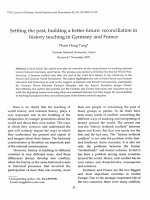
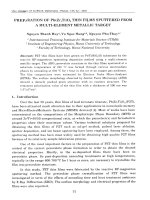
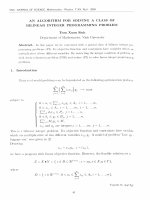
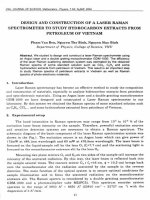
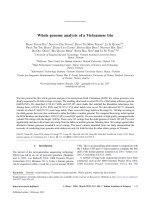
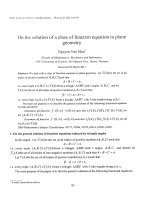


![DSpace at VNU: Bakhtine démasqué [Bakhtin unmasked]: A Reply to Critics](https://media.store123doc.com/images/document/2017_12/16/medium_yue1513244062.jpg)
